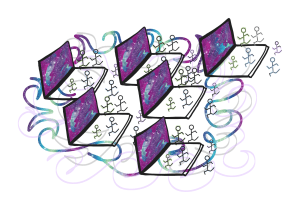
Finishing Wednesday on Netflix felt kind of like losing a friend. After watching an episode per day for eight days, I had spent almost eight hours with the titular character, getting to know her macabre sense of humor. How is it possible that I can feel so close to someone that I’ve never even met, and in the case of fictional characters like Wednesday, someone I can never hope to meet?
Parasocial relationships (PSRs) are characterized by a one-sided feeling of connection with an individual from the media. In other words, it’s a relationship with someone that’s an important part of your life, and meanwhile they … don’t know you exist. Sounds depressing, right?
Researchers from Appalachian State University and Take This, a Seattle-based research organization that specializes in the mental health of gamers, recently published a literature review in Computers in Human Behavior Reports proposing that the imbalance inherent to PSRs may not be so one-sided. The authors suggest that some modern-day PSRs are more like “one-and-a-half-sided relationships.” Historically, fans could only interact with media persona through letters or meet-and-greet events. However, the development of social media sites, especially those with livestream options like Instagram and TikTok, has brought celebrities closer to the public than ever before. For example, Twitch is another platform whose primary appeal is its livestream capacities, contributing to the proliferation of internet “microcelebrities,” or people who have accumulated a large online following by providing specific content. Oftentimes, Twitch streamers centralize their content around a specific video game, for example.
But it’s worth pausing to consider why this genre of internet content garners tens of millions of viewers daily on sites like Twitch. Features such as the chat room allow for back-and-forth communication between the streamer and viewer. The streamer might let the viewers choose what game they will play or exchange advice about game content. The streamer usually can’t respond to everyone’s messages, but there is a robust viewer-streamer bond because of the possibility of interacting. Viewers are able to cultivate a community with like-minded individuals, creating attachments across computer screens, time, and space. The literature review notes that this might entail having “co-experiences” with “shared parasocial partners,” such as rooting for a favorite streamer with fellow viewers, or reaping vicarious enjoyment when the streamer wins a game. The interaction can also spill into other social media applications like Instagram, where fans can interact further by “liking” and commenting.
More broadly, fans benefit from being a part of a “fandom.” This sort of virtual social community partakes in escapism together by consuming the same media content. They also view streamers as role models, a pattern that the researchers call “wishful identification,” tied to a psychological state called “presence” — where the virtual world starts to feel real. This phenomenon is enhanced by unlimited, on-demand access to pre-recorded streams via sites like YouTube. Circling back to Wednesday, the “one-and-a-half-sided” interpretation of PSRs on the internet explains the TikTok trend of the show’s iconic dance, as well as the subsequent virtual interactions between star Jenna Ortega and her fans.
At this point, you might be dubious about these one-and-a-half-sided PSRs. Is it really healthy to lean into the feelings of a not-quite-unrequited friendship? Dr. Rachel Kowert, Research Director at Take This and an author of the literature review, said to me over email, “while parasocial relationships have traditionally been thought of as maladaptive, we now know that these relationships can come with a wealth of mental health benefits.” This is because PSRs are similar to traditional two-sided relationships, conferring some surprising benefits to your well-being. For those with severe depression and anxiety, Twitch can provide an important form of transitional social connection. Watching a livestream can be a healthy way for those prone to self-isolation to engage meaningfully with spaces outside their isolation. Even for those not dealing with these conditions, this type of PSR can provide an opportunity to work through issues or a chance for temporary respite from nagging problems. For example, some livestreamers discuss personal problems that viewers submit in the chat and try to help resolve them. While PSRs certainly demand more investigation, we shouldn’t overlook their benefits in the meantime.
Studying PSRs can help us uncover the inner workings of human relationships. Returning to Wednesday once more, PSRs might be the key to understanding the gloom that comes with wrapping up a new television show. Kowert and her colleague’s research indicates that, surprisingly, watching other people might just help you feel seen.

You must be logged in to post a comment.